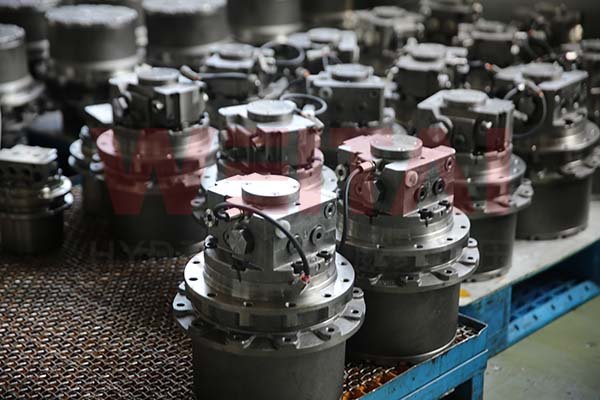Selecting the right travel motor for your crane is crucial for ensuring optimal performance, efficiency, and longevity. The travel motor is responsible for the movement and positioning of the crane, and choosing the wrong type can lead to operational inefficiencies, increased wear and tear, and potential safety hazards. Here are the key factors to consider when choosing a travel motor for your crane.
Load Capacity
The load capacity of the travel motor must align with the maximum weight your crane will handle. Overloading a motor can cause premature failure and unsafe operating conditions. Consider the following:
• Rated Load: Ensure the motor can handle the maximum load of the crane.
• Dynamic Loads: Account for additional forces during crane movement and lifting operations.
• Safety Margins: Incorporate a safety margin above the maximum expected load to account for unforeseen circumstances.
Environmental Conditions
The operating environment significantly impacts motor performance and durability. Consider the following environmental factors:
• Temperature Extremes: Select motors designed for extreme temperatures (hot or cold). Motors with temperature-resistant insulation and cooling mechanisms can help in such conditions.
• Humidity and Corrosion: Opt for motors with corrosion-resistant materials and protective coatings for humid or salty environments, such as coastal or marine applications.
• Dust and Debris: Choose sealed motors to prevent the ingress of dust and debris, especially in construction or mining operations.
Motor Speed and Control
The required speed and control precision depend on the crane’s application. Factors to consider include:
• Variable Speed: Ensure the motor can adjust speeds for different operations, enhancing versatility.
• Precision Control: Look for motors with fine control capabilities for delicate operations or precise positioning during heavy lifting.
• Acceleration/Deceleration: Smooth transitions in speed to prevent load swings, which can be crucial for maintaining stability and safety during operations.
Power Source and Efficiency
The power source and energy efficiency of the travel motor are essential for operational cost and sustainability:
• Electric vs. Hydraulic: Electric motors are more efficient and easier to maintain, making them suitable for many applications. Hydraulic motors, offering higher torque, are preferable for heavy-duty applications requiring significant force.
• Energy Efficiency: Choose motors with high efficiency ratings to reduce energy consumption and costs. Look for motors that meet or exceed industry energy standards.
Compatibility and Integration
The travel motor should be compatible with the existing crane system and easy to integrate:
• Mounting and Dimensions: Ensure the motor fits within the crane’s design specifications, with appropriate mounting options and dimensions.
• Control Systems: Ensure compatibility with the crane’s control systems and ease of integration, allowing for seamless operation.
• Upgradability: Consider motors that offer options for future upgrades without major modifications, facilitating easy improvements and scalability.
Durability and Maintenance
The longevity and ease of maintenance of the travel motor impact the overall lifecycle cost:
• Build Quality: Opt for motors with robust construction and high-quality materials designed to withstand harsh operating conditions.
• Maintenance Requirements: Choose motors with low maintenance needs and easy access for repairs. Features like self-lubricating bearings and diagnostic systems can simplify maintenance.
• Manufacturer Support: Ensure the availability of spare parts and technical support from the manufacturer, providing peace of mind and reducing potential downtime.
Safety Features
Safety is paramount in crane operations. The motor should include features that enhance operational safety:
• Overload Protection: Prevents motor damage and potential accidents from overload conditions by automatically shutting down the motor if the load exceeds the rated capacity.
• Emergency Brakes: Ensures the crane can be safely stopped in case of an emergency, preventing accidents and equipment damage.
• Monitoring Systems: Real-time monitoring systems that provide early detection of issues, allowing for proactive maintenance and avoiding unexpected failures.
Cost and ROI
While cost is a critical factor, it should be balanced against the return on investment (ROI):
• Initial Cost: Consider the upfront cost of the motor, including purchase price and installation expenses.
• Operational Cost: Evaluate ongoing costs such as energy consumption, maintenance, and potential downtime.
• ROI: Calculate the long-term benefits, such as increased efficiency, reduced maintenance costs, and improved safety, to determine the overall value of the investment.
Conclusion
Choosing the right travel motor for your crane involves a comprehensive evaluation of various factors, including load capacity, environmental conditions, motor speed, power source, compatibility, durability, safety features, and cost. By carefully considering these factors, you can ensure that your crane operates efficiently, safely, and reliably, ultimately contributing to the success of your operations. Investing in the right travel motor not only enhances performance but also reduces long-term operational costs and improves overall productivity.



